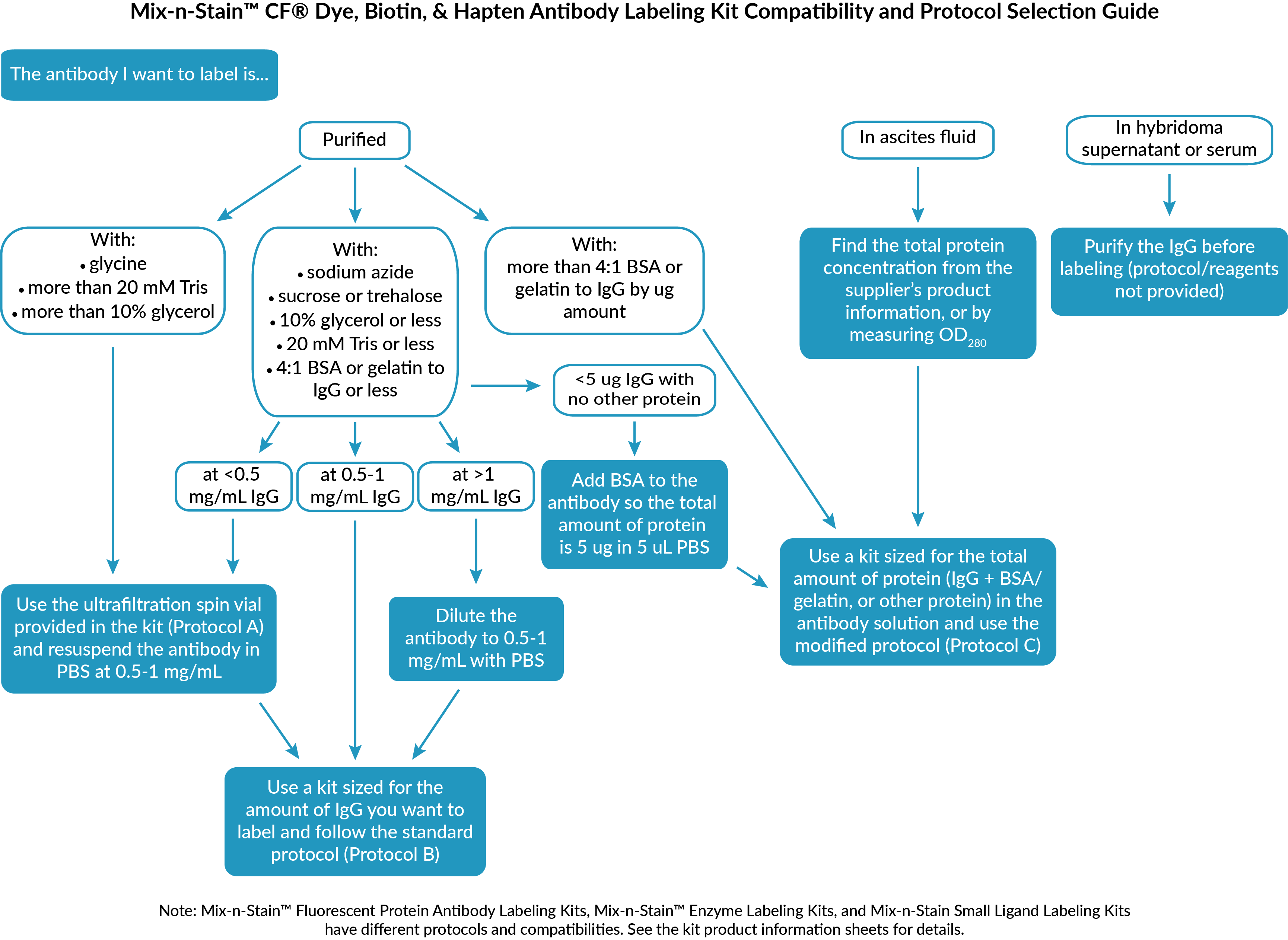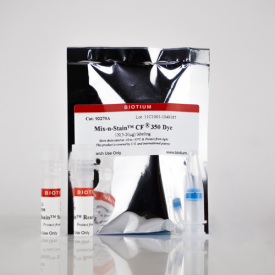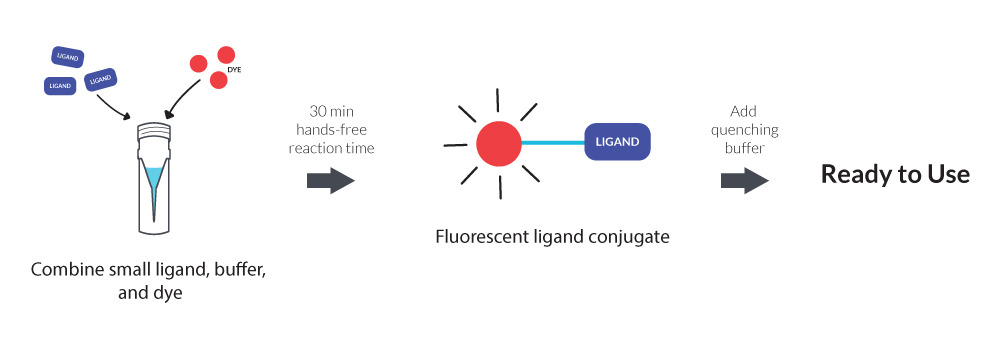MIX-N-STAIN™ CF® DYE ANTIBODY LABELING TECHNOLOGY
Mix-n-Stain™ antibody labeling kits dramatically simplify the process of antibody labeling. The resulting conjugates perform comparably to pre-labeled antibodies from leading suppliers. Because the labeling is covalent, the conjugates are stable for long-term storage, and ideal for multi-color imaging and multiplex flow cytometry.
Each Mix-n-Stain™ kit comes with everything you need to perform the conjugation. Without a separation step, you will have an optimally labeled antibody conjugate ready to be used in any immunofluorescence staining experiment.
One breakthrough feature of Mix-n-Stain™ kits is that antibody labeling can be conducted in the presence of many common buffer components such as BSA, gelatin, azide and low concentrations of Tris. As a result, the kits are compatible with most commercial antibody formulations without an antibody purification step prior to the conjugation process.
See below for our selection of Mix-n-Stain™ kits with a variety of label options.
Rapid Antibody Labeling with Next-Generation Fluorescent CF® Dyes, Biotin, & More
With Mix-n-Stain™ CF® Dye Antibody Labeling Kits, you can covalently label as little as ≤5 ug up to 100 ug of an antibody in just 15 minutes, with minimal hands-on time and 100% recovery of antibody. With slight modification in protocol, antibodies can be labeled in the presence of BSA, gelatin, or ascites fluid, for unrivaled convenience. See the Compatibility and Protocol Selection Flowchart below, or download the Product Protocol for a step-by-step worksheet to determine kit compatibility with your antibody.
These kits feature a choice of over 30 superior CF® Dyes, which have advantages in brightness and photostability compared to other commercially available fluorescent dyes. Due to the high water solubility of CF® Dyes, other proteins like BSA or gelatin in the labeling reaction have minimal effect on non-specific background, because non-IgG proteins are washed away during IF staining. We also offer Mix-n-Stain™ kits for biotin, FITC, DIG, and DNP labeling, as well as Mix-n-Stain™ Maxi Antibody Labeling Kits for 1 mg scale labeling reactions.
Features:
- 3 kit sizes: 5-20 ug, 20-50 ug, or 50-100 ug Ab
- Choice of over 30 CF® Dye colors, biotin, FITC, or haptens
- Less than 30 seconds of hands-on time
- 15 minutes total reaction time
- No purification of the product is required
- Compatible with common antibody stabilizers
Compatible with antibody stabilizers and ascites
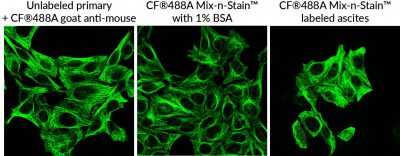
Combine direct & indirect IF for flexible multiplexing
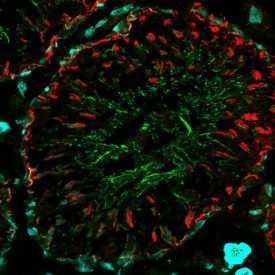
Featuring CF® Dyes with superior brightness
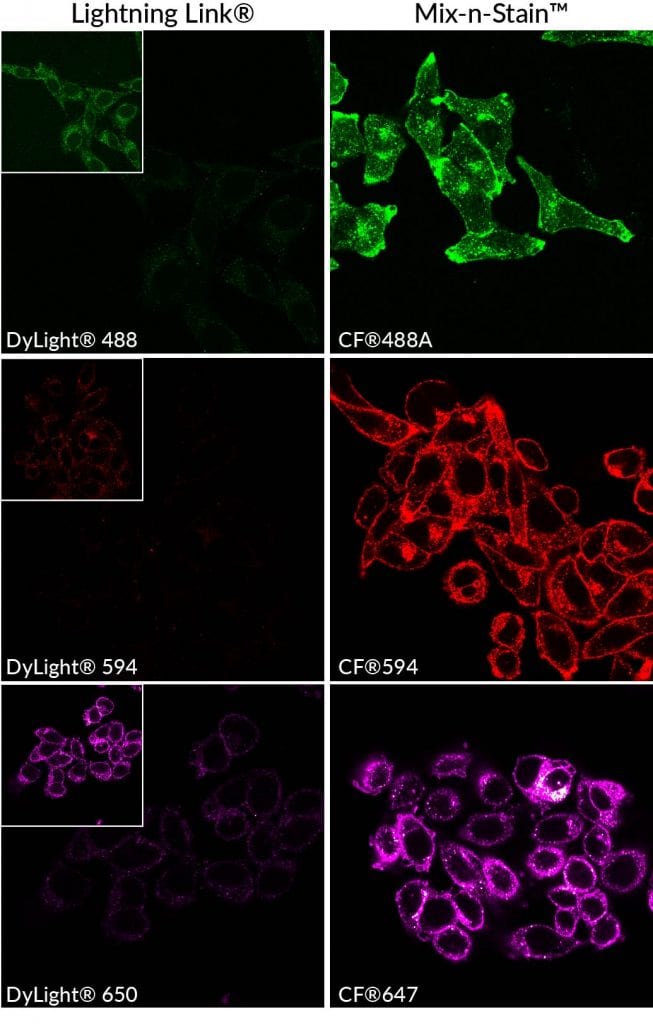
Mix-n-Stain™ CF® Dye, Biotin, FITC & Hapten IgG Antibody Labeling Kits
| Product description | Label options | Labeling time |
|---|---|---|
| Mix-n-Stain™ CF® Dye Antibody Labeling Kits | Choice of over 30 bright & photostable CF® Dyes | 15 minutes (~30 seconds hands-on time) Download the product protocol |
| Mix-n-Stain™ Cyanine Dye Antibody Labeling Kits |
Cyanine 555 Cyanine 647 |
|
| Mix-n-Stain™ FITC Antibody Labeling Kits | FITC | |
| Mix-n-Stain™ Biotin Antibody Labeling Kits | Biotin | |
| Mix-n-Stain™ DNP Antibody Labeling Kits | DNP | |
| Mix-n-Stain™ Digoxigenin Antibody Labeling Kits | Digoxigenin (DIG) | |
| Mix-n-Stain™ Maxi Antibody Labeling Kits | Choice of 13 bright & photostable CF® Dyes, FITC, Cyanine 555, and Cyanine 647 | 30 minutes (~30 seconds hands-on time) |
| Mix-n-Stain™ STORM CF® Antibody Labeling Kits | Choice of 8 CF® Dyes specialized for STORM super-resolution microscopy |
MIX-N-STAIN™ CF® DYE IGM ANTIBODY LABELING KITS
Finally! Simple & Efficient Labeling of IgM Antibodies
IgM antibodies are difficult to label with fluorescent dyes because the conditions typically used for labeling IgG generally do not result in bright conjugates with good antibody reactivity for IgM. Biotium has resolved this issue by optimizing the reaction conditions for labeling IgM antibodies with Mix-n-Stain™ CF® Dye IgM Antibody Labeling Kits.
Features
- Label 25 ug or 100 ug of IgM antibody
- Choice of 8 CF® Dye colors and FITC
- 15-30 minute total reaction time
- No purification, 100% recovery
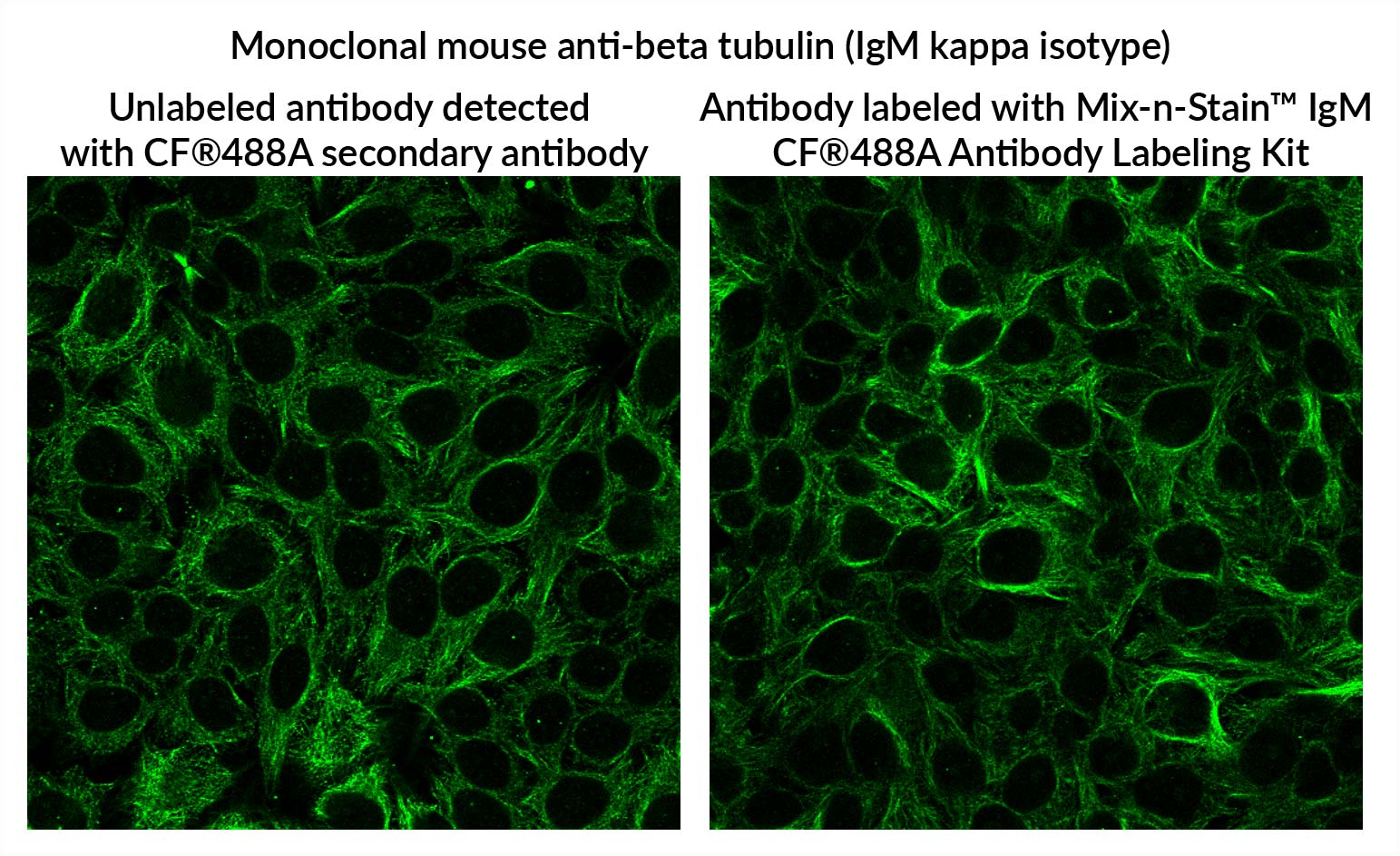
Mix-n-Stain™ CF® Dye IgM Antibody Labeling Kits
| Conjugation | Ex/Em | Size | Catalog No. | Dye Features |
|---|---|---|---|---|
| CF®405L | 413/547 nm | 25 ug | 92558 | CF®405L Features |
| 100 ug | 92559 | |||
| CF®405M | 416/452 nm | 25 ug | 92560 | CF®405M Features |
| 100 ug | 92561 | |||
| CF®488A | 490/516 nm | 25 ug | 92562 | CF®488A Features |
| 100 ug | 92563 | |||
| CF®555 | 554/568 nm | 25 ug | 92564 | CF®555 Features |
| 100 ug | 92565 | |||
| CF®568 | 562/583 nm | 25 ug | 92566 | CF®568 Features |
| 100 ug | 92567 | |||
| CF®594 | 593/615 nm | 25 ug | 92568 | CF®594 Features |
| 100 ug | 92569 | |||
| CF®640R | 642/663 nm | 25 ug | 92570 | CF®640R Features |
| 100 ug | 92571 | |||
| CF®647 | 652/668 nm | 25 ug | 92572 | CF®647 Features |
| 100 ug | 92573 | |||
| FITC | 498/517 nm | 25 ug | 92574 | |
| 100 ug | 92575 |
MIX-N-STAIN™ NANOBODY LABELING KITS
Mix-n-Stain™ Nanobody Labeling Kits are designed specifically for labeling single-domain Nanobodies® (also called camelid single variable or VHH domains) with one of Biotium’s bright and photostable CF® Dyes or biotin. The kits allow optimal labeling of between 5-50 ug of Nanobody® in just 30 minutes, with minimal hands-on time and no purification. Labeling tolerates common buffer additives, including BSA.
The kits come with a selection of our next-generation CF® Dyes or biotin. CF® Dyes have advantages in brightness and photostability compared to other commercially available fluorescent dyes (learn more about CF® Dyes).
Features
- Label 5-20 ug or 20-50 ug of Nanobody®
- Choice of 7 CF® Dye colors or biotin
- Simple 30 minute labeling, no purification
- Compatible with common stabilizers
- Dye options for super-resolution and 2-photon imaging (learn more)
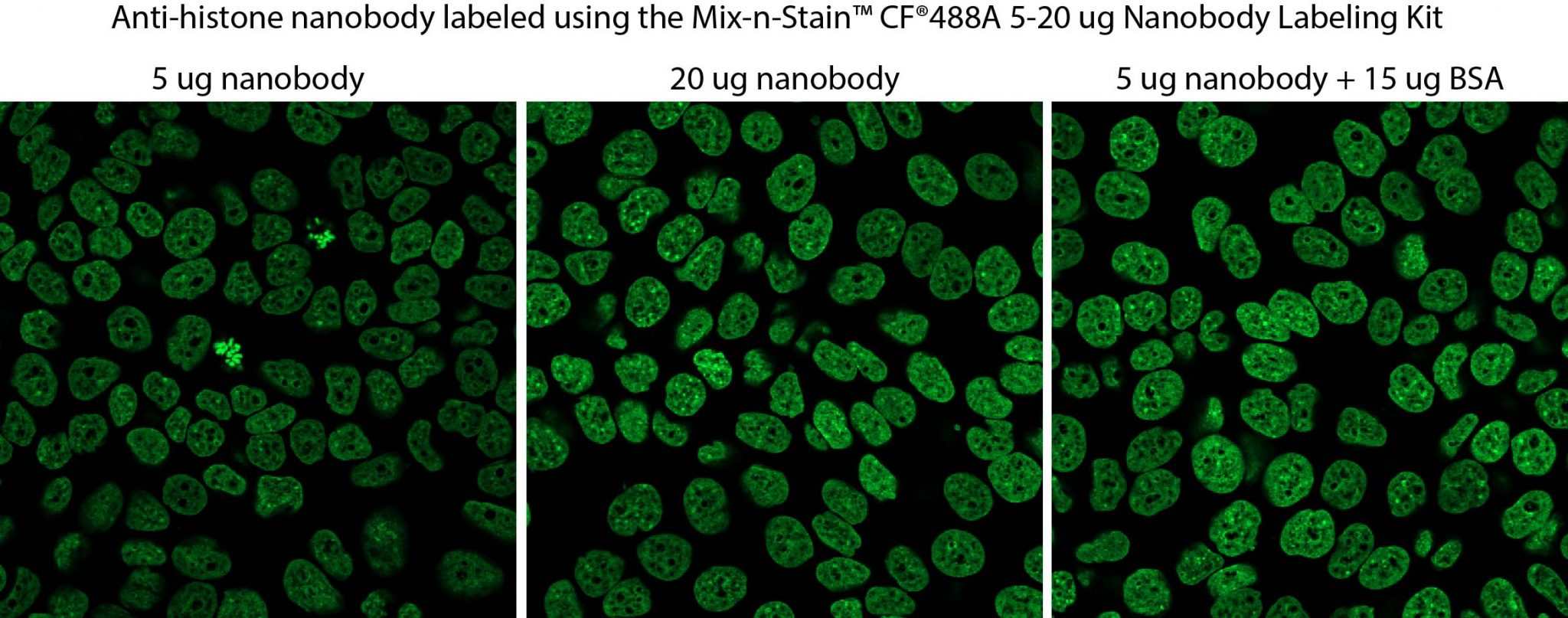

Mix-n-Stain™ Nanobody Labeling Kits
| Label | Ex/Em | Labeling size (ug Nanobody®) |
Catalog number |
|---|---|---|---|
| Biotin | N/A | 5-20 ug | 92500 |
| 20-50 ug | 92501 | ||
| CF®405S | 404/431 nm | 5-20 ug | 92502 |
| 20-50 ug | 92503 | ||
| CF®488A | 490/515 nm | 5-20 ug | 92504 |
| 20-50 ug | 92505 | ||
| CF®568 | 562/583 nm | 5-20 ug | 92506 |
| 20-50 ug | 92507 | ||
| CF®594 | 593/614 nm | 5-20 ug | 92508 |
| 20-50 ug | 92509 | ||
| CF®640R | 642/662 nm | 5-20 ug | 92510 |
| 20-50 ug | 92511 | ||
| CF®647 | 650/665 nm | 5-20 ug | 92512 |
| 20-50 ug | 92513 | ||
| CF®680R | 680/701 nm | 5-20 ug | 92514 |
| 20-50 ug | 92515 |
MIX-N-STAIN™ STORM CF® DYE ANTIBODY LABELING KITS
Mix-n-Stain™ STORM CF® Dye Antibody Labeling Kits offer a choice of 8 CF® Dyes developed with superior brightness and unique photoswitching properties that are ideal for super-resolution imaging by STORM. In addition, these specialized antibody labeling kits are designed to offer a low degree of labeling (DOL, or dye molecules per antibody molecule) of 1-2.5, which is reported to be optimal for STORM (Bittel et al. 2015). Biotium has also developed novel green-excited STORM dyes CF®583R and CF®597R to expand the color palette for multi-color STORM. Learn more about the UC Berkeley and Biotium collaboration paper on CF®583R and CF®597R dyes for STORM.
Features
- Choice of 8 CF® Dye colors ideal for STORM
- CF®583R and CF®597R are novel green-excited STORM dyes
- Labeling optimized to provide low 1-2.5 DOL
- Less than 30 seconds of hands-on time
- 30 minutes total reaction time
- No purification, 100% recovery
Learn more about CF® Dyes for STORM or our other fluorescent reagents validated for super-resolution microscopy.
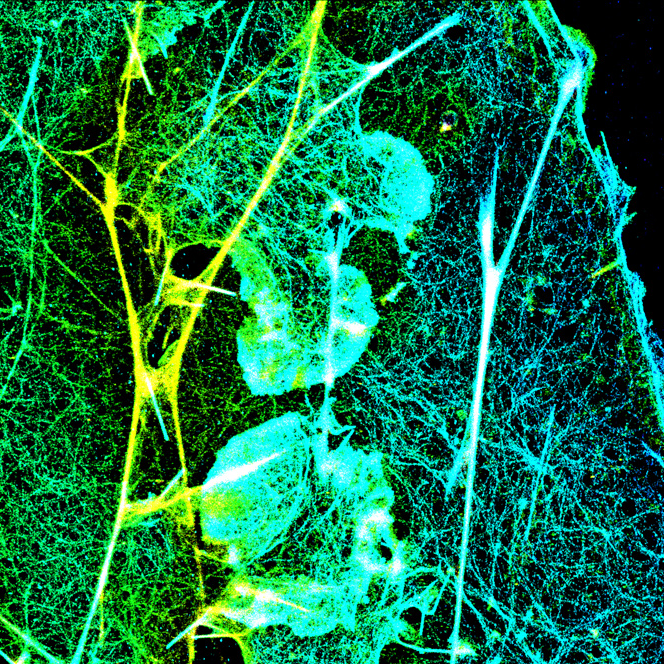
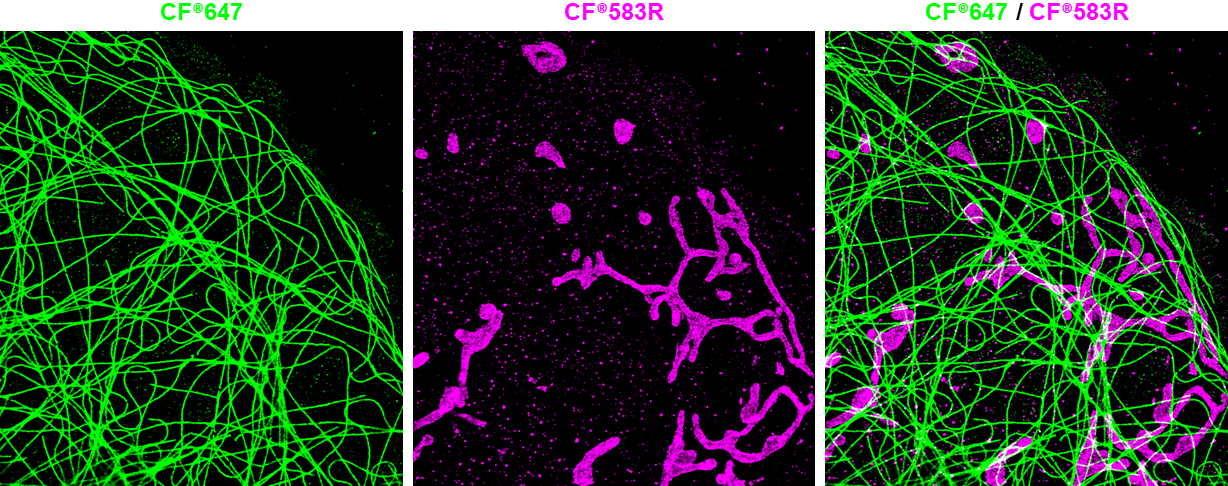
Mix-n-Stain™ STORM CF® Dye Antibody Labeling Kits
| Conjugation | Ex/Em | Size | Catalog No. | Dye Features |
|---|---|---|---|---|
| CF®505 | 505/519 nm | 50 ug | 92549 | |
| CF®568 | 562/584 nm | 50 ug | 92550 | CF®568 Features |
| CF®583R | 585/609 nm | 50 ug | 92551 | CF®583R Features |
| CF®597R | 597/619 nm | 50 ug | 92553 | CF®597R Features |
| CF®647 | 652/668 nm | 50 ug | 92554 | CF®647 Features |
| CF®660C | 667/685 nm | 50 ug | 92555 | CF®660C Features |
| CF®680 | 681/698 nm | 50 ug | 92556 | CF®680 Features |
| CF®750 | 755/779 nm | 50 ug | 92557 | CF®750 Features |
MIX-N-STAIN™ CF® DYE SMALL LIGAND LABELING KITS
Mix-n-Stain™ CF® Dye small ligand labeling kits are designed for rapid labeling of small (MW ~ 150 – 5,000) and relatively high affinity biological ligands (or substrates). Labeling takes about 30 minutes, without a final purification step. The ligands to be labeled must contain an aliphatic amine group that is not required for biological activity of the ligand. The amine group will form a covalent linkage with the reactive CF® Dye provided in the kit. For example, suitable ligands or substrates include SNAP-tag®, CLIP-tag™ and HaloTag® ligands with an aliphatic amine. Many other small ligands are also possible candidates if they meet the criteria described above.
Simply mix your small molecule ligand with the reaction buffer and the optimally formulated dye provided, and incubate for 30 minutes, followed by a brief 5 minute quenching step. No reactive Mix-n-Stain™ dye is available at the end of labeling; therefore the conjugate is ready for cell staining and imaging without further purification. Mix-n-Stain™ labeled ligands perform comparably to commercially-available pre-labeled ligands (Figure 1), at a fraction of the cost.
For live cell imaging, the Mix-n-Stain™ small ligand kits are ideal to generate fluorescent chemical tags that provide smaller, brighter, and more versatile alternatives to fluorescent proteins. Labeling of various chemical tags with Mix-n-Stain™ kits yielded highly efficient and specific labeling of the target proteins both on surface and inside of living cells. The Mix-n-Stain™ small ligand kits have also been proven compatible with fixed cell imaging and gel-based assays.
Features:
- Choice of 10 CF® Dye colors for extracellular staining
- Choice of 5 CF® Dye colors for intracellular staining
- For labeling molecules with a MW of 150-5000, containing an inactive aliphatic amine
- Suitable ligands or substrates include SNAP-tag®, CLIP-tag™ and HaloTag® ligands
- 30 minutes total reaction time, no purification necessary
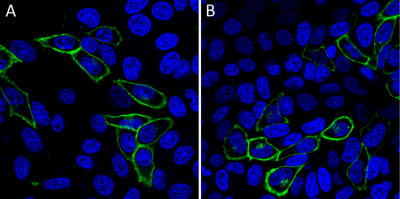
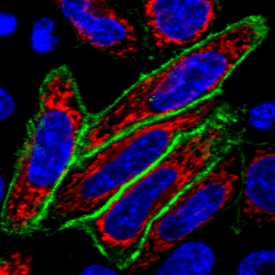
Mix-n-Stain™ Small Ligand Kits
| Product description | Label options | Labeling time |
|---|---|---|
| Mix-n-Stain™ CF® Dye Small Molecule Labeling Kits | Extracellular Staining: Choice of 10 bright and stable CF® Dyes | ~30 minutes (minimal hands-on time) Download the product protocol |
| Intracellular Staining: Choice of 5 bright and stable CF® Dyes |
CF® DYE SE
PROTEIN LABELING KITS
CF® Dye SE Protein Labeling Kits allow you to label your antibody of interest with one of our many bright and photostable CF® Dyes. The difference is that while the Mix-n-Stain™ kits come optimized for consistent labeling of small amounts of antibody, the SE Protein Labeling Kits are designed for 3 labelings of up to 1 mg protein with removal of free dye after labeling. The SE Protein Labeling Kits allow the user to optimize the amount of dye and antibody and determine the degree of protein labeling, for optimization of labeling and antibody performance.
Features:
- Choice of 19 CF® Dye colors or biotin
- Reagents for 3 labeling reactions with purification
- Each reaction can label up to 1 mg of antibody or protein
- Includes instructions for determining degree of labeling
VIVOBRITE™ NEAR-IR ANTIBODY LABELING KITS FOR IN VIVO IMAGING
VivoBrite™ Antibody Labeling Kits use the same labeling technology as our SE Protein Labeling Kits. The kits include the same components as the SE Protein Labeling Kits, with the addition of a syringe and syringe filter to sterile filter the labeled protein, allowing it to be used for in vivo small animal studies. The VivoBrite™ kits are offered in 4 near-IR CF® Dye colors, which are useful for small animal in vivo imaging. Biotium’s near-IR fluroescent dyes are best in class for brightness, photostability, and water solubility.
Features:
- Choice of 4 near-IR CF® Dye colors
- Kit contains reagents for 3 labeling reactions
- Each reaction can label up to 1 mg of antibody
- Kit can also be used to label other proteins
- The resulting labeled protein is purified and sterile
Protein Labeling Kits
| Product description | Label options | Product protocol |
|---|---|---|
| CF® Dye SE Protein Labeling Kits | 19 CF® Dye colors across the spectrum, plus biotin | PI-CF® Dye SE Protein Labeling Kits |
| VivoBrite™ Antibody Labeling Kits for Small Animal In Vivo Imaging | 4 near-IR CF® Dyes | PI-VivoBrite™ Antibody Labeling Kits |
Associated products
Mix-n-Stain™ Biotin Antibody Labeling Kit
92444, 92244, 92266, - 92286View allHide
Mix-n-Stain™ CF® Dye Antibody Labeling Kits
92576, 92577, 92578, 92582, 92583, 92584, 92579, 92580, 92581, 92458, 92459, 92460, 92457, 92456, 92455, 92463, 92462, 92461, 92446, 92445, 92447, 92448, 92449, 92433, 92432, 92431, 92430, 92429, 92428, 92427, 92426, 92425, 92230, 92231, 92232, 92233, 92234, 92235, 92236, 92237, 92238, 92239, 92240, 92241, 92242, 92243, 92245, 92246, 92247, 92248, 92250, 92251, 92252, 92253, 92254, 92255, 92256, 92257, 92258, 92259, 92260, 92261, 92262, 92263, 92264, 92265, 92267, 92268, 92270, 92271, 92272, 92273, 92274, 92275, 92276, 92277, 92278, 92279, 92280, 92281, 92282, 92283, 92284, 92285, 92287, 92288, 92289, 92290, 92291, 92303, 92304, 92305, 92316, 92317, 92318, 92319, 92320, 92321, 92322, 92323, 92324, 92331, 92332, 92333, 92334, 92335, 92336, 92337, 92338, - 92339View allHide
Mix-n-Stain™ CF® Dye Small Ligand Labeling Kits
92350, 92351, 92352, 92353, 92354, 92355, 92356, 92357, 92358, 92359, 92360, 92361, 92362, 92363, - 92364View allHide
Mix-n-Stain™ Digoxigenin Antibody Labeling Kit
92450, 92328, 92329, - 92330View allHide
Mix-n-Stain™ FITC Antibody Labeling Kit
92294, 92295, - 92296View allHide
CF® Dye & Biotin SE Protein Labeling Kits
92208, 92209, 92210, 92211, 92212, 92213, 92214, 92215, 92216, 92217, 92218, 92219, 92220, 92221, 92222, 92223, 92224, 92225, 92226, - 92228View allHide
VivoBrite™ Rapid Antibody Labeling Kits for Small Animal In Vivo Imaging
92160, 92161, 92162, - 92163View allHide
Mix-n-Stain™ Maxi Antibody Labeling Kits, 1 mg Labeling
92454, 92415, 92419, 92420, 92404, 92421, 92405, 92406, 92407, 92408, 92409, 92410, 92422, 92423, 92424, - 92411View allHide
Mix-n-Stain™ Nanobody Labeling Kits
92501, 92500, 92502, 92503, 92504, 92505, 92506, 92507, 92508, 92509, 92510, 92511, 92512, 92513, 92514, - 92515View allHide

